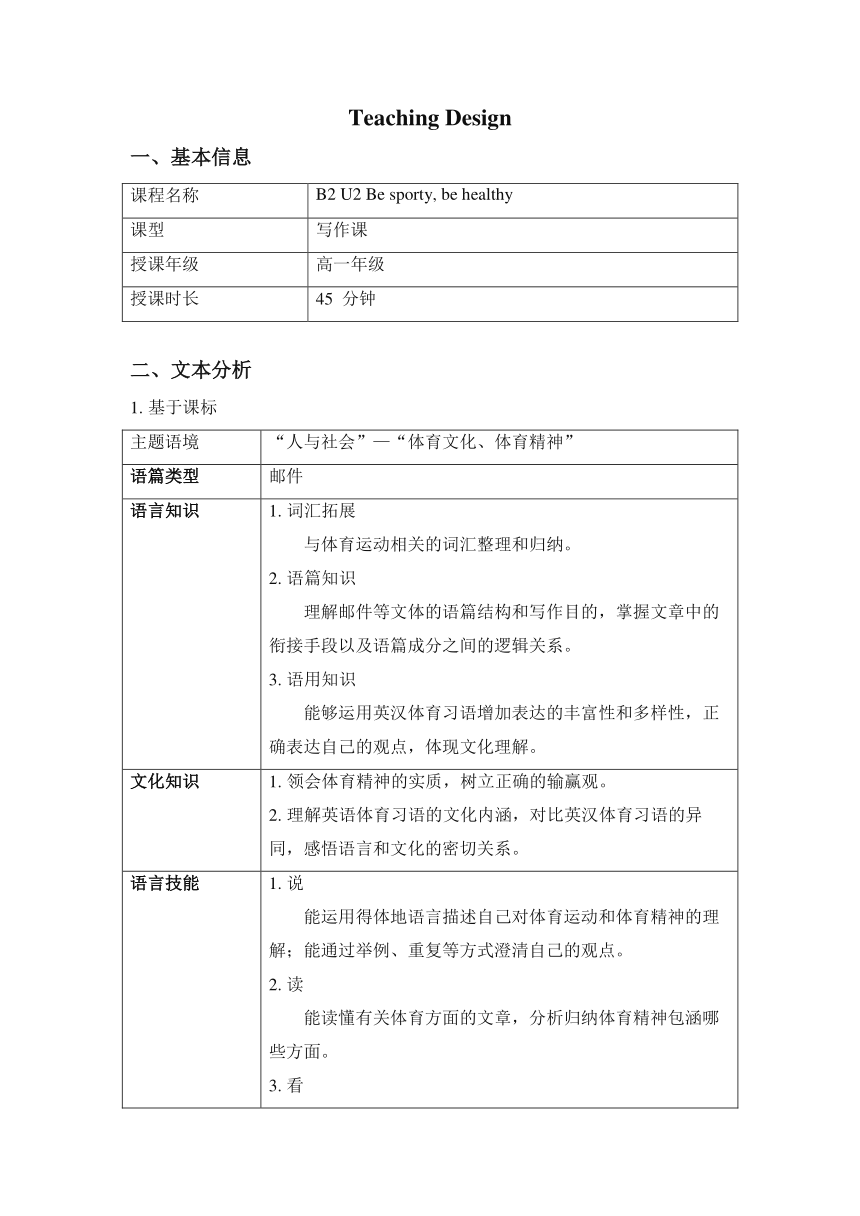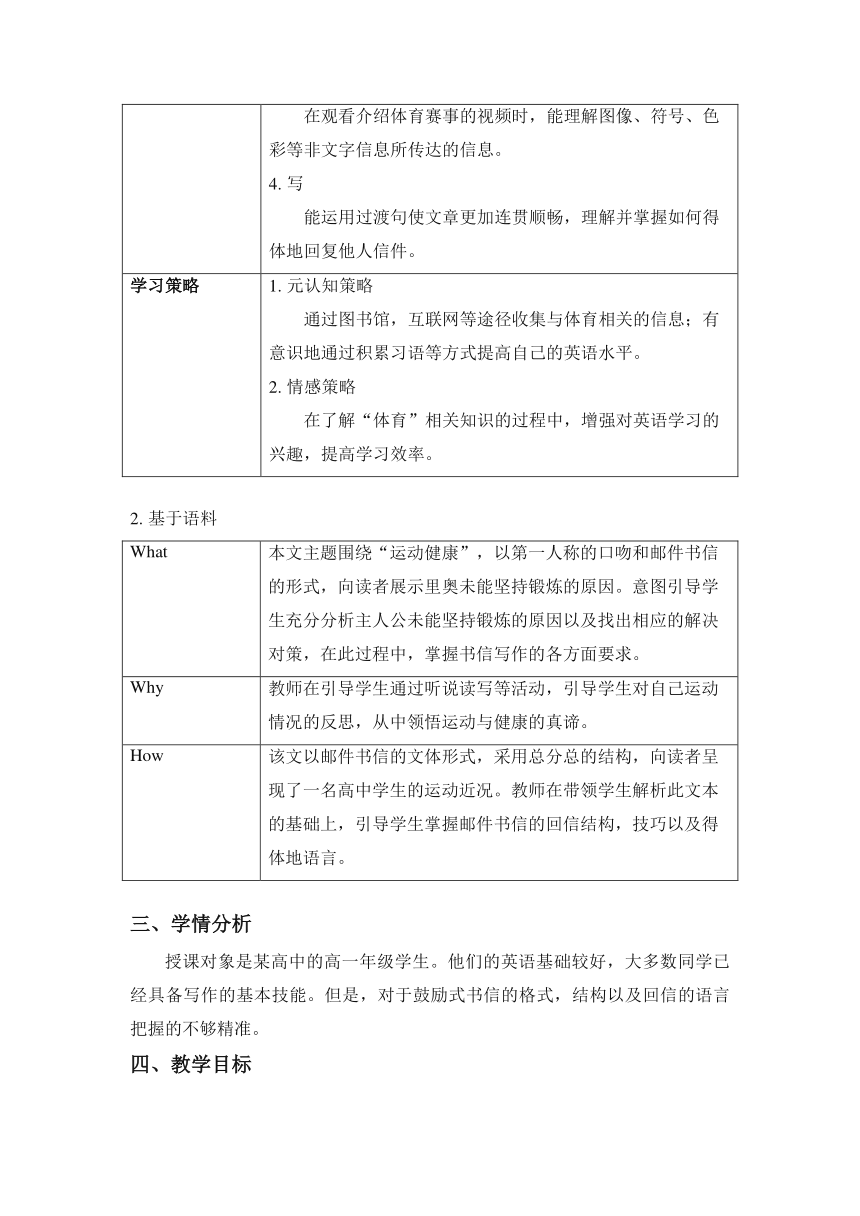牛津译林版(2019)必修 第二册Unit 2 Be sporty,be healthy Integrated Skills写作教学设计
文档属性
| 名称 | 牛津译林版(2019)必修 第二册Unit 2 Be sporty,be healthy Integrated Skills写作教学设计 |

|
|
| 格式 | docx | ||
| 文件大小 | 35.0KB | ||
| 资源类型 | 教案 | ||
| 版本资源 | 牛津译林版(2019) | ||
| 科目 | 英语 | ||
| 更新时间 | 2024-03-14 20:24:34 | ||
图片预览


文档简介
Teaching Design
基本信息
课程名称 B2 U2 Be sporty, be healthy
课型 写作课
授课年级 高一年级
授课时长 45 分钟
文本分析
基于课标
主题语境 “人与社会”—“体育文化、体育精神”
语篇类型 邮件
语言知识 词汇拓展 与体育运动相关的词汇整理和归纳。 语篇知识 理解邮件等文体的语篇结构和写作目的,掌握文章中的衔接手段以及语篇成分之间的逻辑关系。 语用知识 能够运用英汉体育习语增加表达的丰富性和多样性,正确表达自己的观点,体现文化理解。
文化知识 领会体育精神的实质,树立正确的输赢观。 理解英语体育习语的文化内涵,对比英汉体育习语的异同,感悟语言和文化的密切关系。
语言技能 说 能运用得体地语言描述自己对体育运动和体育精神的理解;能通过举例、重复等方式澄清自己的观点。 读 能读懂有关体育方面的文章,分析归纳体育精神包涵哪些方面。 看 在观看介绍体育赛事的视频时,能理解图像、符号、色彩等非文字信息所传达的信息。 写 能运用过渡句使文章更加连贯顺畅,理解并掌握如何得体地回复他人信件。
学习策略 元认知策略 通过图书馆,互联网等途径收集与体育相关的信息;有意识地通过积累习语等方式提高自己的英语水平。 情感策略 在了解“体育”相关知识的过程中,增强对英语学习的兴趣,提高学习效率。
基于语料
What 本文主题围绕“运动健康”,以第一人称的口吻和邮件书信的形式,向读者展示里奥未能坚持锻炼的原因。意图引导学生充分分析主人公未能坚持锻炼的原因以及找出相应的解决对策,在此过程中,掌握书信写作的各方面要求。
Why 教师在引导学生通过听说读写等活动,引导学生对自己运动情况的反思,从中领悟运动与健康的真谛。
How 该文以邮件书信的文体形式,采用总分总的结构,向读者呈现了一名高中学生的运动近况。教师在带领学生解析此文本的基础上,引导学生掌握邮件书信的回信结构,技巧以及得体地语言。
学情分析
授课对象是某高中的高一年级学生。他们的英语基础较好,大多数同学已经具备写作的基本技能。但是,对于鼓励式书信的格式,结构以及回信的语言把握的不够精准。
教学目标
感悟运动健康的精神内涵,认可运动健身带来的益处。
能采用适当的写作结构,技巧以及适宜的语言完成一篇邮件回信。
通过阅读杂志文章,了解英语体育习语的文体内涵,学会灵活使用各种习语。
教学重难点
教学重点
帮助学生梳理文本脉络,掌握文本结构和相关信息。
引导学生掌握书信写作结构,技巧以及相应的语言风格。
教学难点:
促使学生明晰写作的对象,进而明确自己的写作内容。
引导学生培养积极向上的运动方式。
教学流程
Teaching Procedures:
Step 1 Lead-in ( 5 minutes)
T arouses Ss’ interest by presenting a picture and asking some related questions.
Do you exercise regularly What exercise do you usually do
How do you make exercise a regular part of your life
T summarizes Ss’ ways of making exercise a regular part of their life.
(Justification: These questions and the picture can arouse students' interest in this lesson, provide students with an opportunity to combine their experience to this lesson, and lead in the topic naturally.)
Step 2 Pre-writing (15 minutes)
Activity 1 Reading for writing
Teacher asks Ss to read the email and find out the main reasons why Leo is unwilling to take up exercise.
(Justification: Return to the book, help students understand Leo’s problem better).
Activity 2 Discussion
T asks Ss to discuss their suggestions for Leo’s problems.
(Justification: discussion can help students improve their oral ability and come up with some solutions to prepare for the following writing.)
Step 3 While-writing ( 18 mins )
Writing a reply to encourage Leo to work out regularly.
T introduces Ss the task of writing
T shows Ss the steps of writing.
Prewriting
T shows Ss what they are supposed to do during the prewriting step.
T asks Ss to get the ideas.
T introduces the structure that Ss should follow to write an email of encouragement.
T explains the techniques of writing an email of encouragement.
T leads Ss to pay attention to the language features of writing an email of encouragement: informal and proper.
(Justification: These skills help students be better prepared for writing.)
Drafting
T: In this step, students are supposed to put the ideas on paper according to the outline they have drawn.
Revising
Ask students to review the writing first by themself and then by their partner.
Step 4 Post-writing ( 5 mins )
Activity 1 Editing
Students are asked to check their works again based on the given criteria: pay attention to the capitalization, the usage and grammar, the punctuation and the spelling.
(Justification: By giving the criteria, students can make some pointed improvements for their works.)
Activity 2 Publishing
T asks Ss to share their writing with the rest of the class.
(Justification: Through a series of activities, give students specific writing suggestions, guide students to grasp the main points of writing, and finally improve their writing ability.)
Summary and Homework (2 minutes)
(1) Summary
Ask one student to summarize what they have learned in this class.
(Justification: Train students concluding ability.)
(2) Homework
Polish up your writing. According to suggestions from partners, students continue polishing their works and submit the final version of their works.
(Justification: Homework is necessary for students to review and consolidate what they learned in this class. It will check whether the students achieve the teaching objectives.)
Blackboard Design:
基本信息
课程名称 B2 U2 Be sporty, be healthy
课型 写作课
授课年级 高一年级
授课时长 45 分钟
文本分析
基于课标
主题语境 “人与社会”—“体育文化、体育精神”
语篇类型 邮件
语言知识 词汇拓展 与体育运动相关的词汇整理和归纳。 语篇知识 理解邮件等文体的语篇结构和写作目的,掌握文章中的衔接手段以及语篇成分之间的逻辑关系。 语用知识 能够运用英汉体育习语增加表达的丰富性和多样性,正确表达自己的观点,体现文化理解。
文化知识 领会体育精神的实质,树立正确的输赢观。 理解英语体育习语的文化内涵,对比英汉体育习语的异同,感悟语言和文化的密切关系。
语言技能 说 能运用得体地语言描述自己对体育运动和体育精神的理解;能通过举例、重复等方式澄清自己的观点。 读 能读懂有关体育方面的文章,分析归纳体育精神包涵哪些方面。 看 在观看介绍体育赛事的视频时,能理解图像、符号、色彩等非文字信息所传达的信息。 写 能运用过渡句使文章更加连贯顺畅,理解并掌握如何得体地回复他人信件。
学习策略 元认知策略 通过图书馆,互联网等途径收集与体育相关的信息;有意识地通过积累习语等方式提高自己的英语水平。 情感策略 在了解“体育”相关知识的过程中,增强对英语学习的兴趣,提高学习效率。
基于语料
What 本文主题围绕“运动健康”,以第一人称的口吻和邮件书信的形式,向读者展示里奥未能坚持锻炼的原因。意图引导学生充分分析主人公未能坚持锻炼的原因以及找出相应的解决对策,在此过程中,掌握书信写作的各方面要求。
Why 教师在引导学生通过听说读写等活动,引导学生对自己运动情况的反思,从中领悟运动与健康的真谛。
How 该文以邮件书信的文体形式,采用总分总的结构,向读者呈现了一名高中学生的运动近况。教师在带领学生解析此文本的基础上,引导学生掌握邮件书信的回信结构,技巧以及得体地语言。
学情分析
授课对象是某高中的高一年级学生。他们的英语基础较好,大多数同学已经具备写作的基本技能。但是,对于鼓励式书信的格式,结构以及回信的语言把握的不够精准。
教学目标
感悟运动健康的精神内涵,认可运动健身带来的益处。
能采用适当的写作结构,技巧以及适宜的语言完成一篇邮件回信。
通过阅读杂志文章,了解英语体育习语的文体内涵,学会灵活使用各种习语。
教学重难点
教学重点
帮助学生梳理文本脉络,掌握文本结构和相关信息。
引导学生掌握书信写作结构,技巧以及相应的语言风格。
教学难点:
促使学生明晰写作的对象,进而明确自己的写作内容。
引导学生培养积极向上的运动方式。
教学流程
Teaching Procedures:
Step 1 Lead-in ( 5 minutes)
T arouses Ss’ interest by presenting a picture and asking some related questions.
Do you exercise regularly What exercise do you usually do
How do you make exercise a regular part of your life
T summarizes Ss’ ways of making exercise a regular part of their life.
(Justification: These questions and the picture can arouse students' interest in this lesson, provide students with an opportunity to combine their experience to this lesson, and lead in the topic naturally.)
Step 2 Pre-writing (15 minutes)
Activity 1 Reading for writing
Teacher asks Ss to read the email and find out the main reasons why Leo is unwilling to take up exercise.
(Justification: Return to the book, help students understand Leo’s problem better).
Activity 2 Discussion
T asks Ss to discuss their suggestions for Leo’s problems.
(Justification: discussion can help students improve their oral ability and come up with some solutions to prepare for the following writing.)
Step 3 While-writing ( 18 mins )
Writing a reply to encourage Leo to work out regularly.
T introduces Ss the task of writing
T shows Ss the steps of writing.
Prewriting
T shows Ss what they are supposed to do during the prewriting step.
T asks Ss to get the ideas.
T introduces the structure that Ss should follow to write an email of encouragement.
T explains the techniques of writing an email of encouragement.
T leads Ss to pay attention to the language features of writing an email of encouragement: informal and proper.
(Justification: These skills help students be better prepared for writing.)
Drafting
T: In this step, students are supposed to put the ideas on paper according to the outline they have drawn.
Revising
Ask students to review the writing first by themself and then by their partner.
Step 4 Post-writing ( 5 mins )
Activity 1 Editing
Students are asked to check their works again based on the given criteria: pay attention to the capitalization, the usage and grammar, the punctuation and the spelling.
(Justification: By giving the criteria, students can make some pointed improvements for their works.)
Activity 2 Publishing
T asks Ss to share their writing with the rest of the class.
(Justification: Through a series of activities, give students specific writing suggestions, guide students to grasp the main points of writing, and finally improve their writing ability.)
Summary and Homework (2 minutes)
(1) Summary
Ask one student to summarize what they have learned in this class.
(Justification: Train students concluding ability.)
(2) Homework
Polish up your writing. According to suggestions from partners, students continue polishing their works and submit the final version of their works.
(Justification: Homework is necessary for students to review and consolidate what they learned in this class. It will check whether the students achieve the teaching objectives.)
Blackboard Design:
